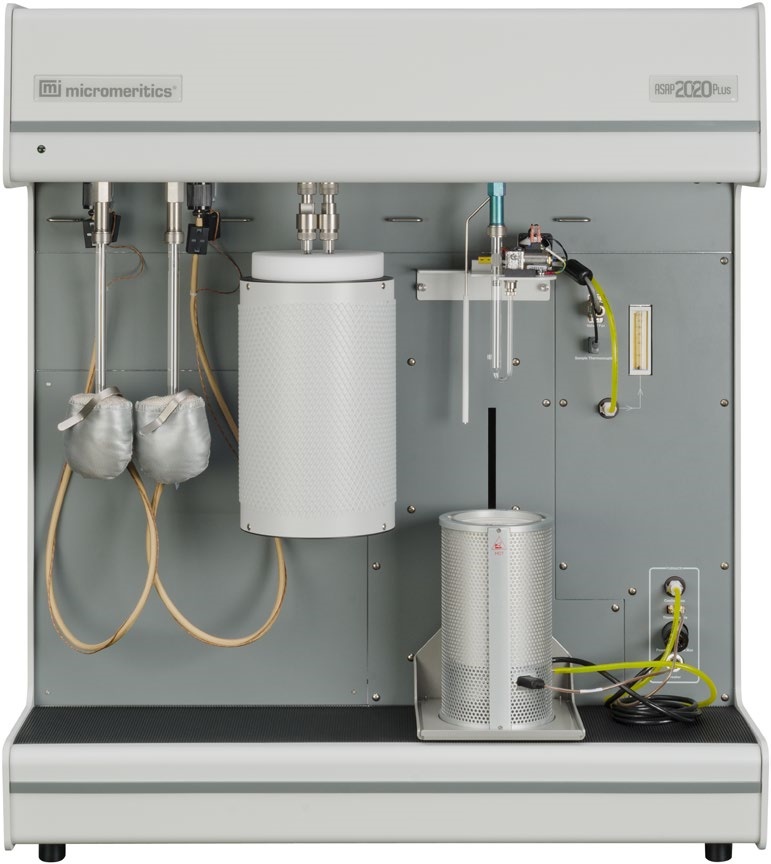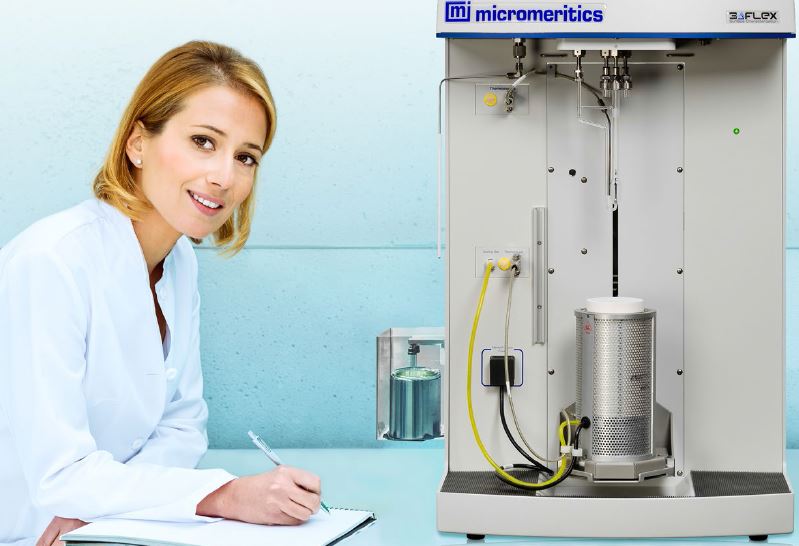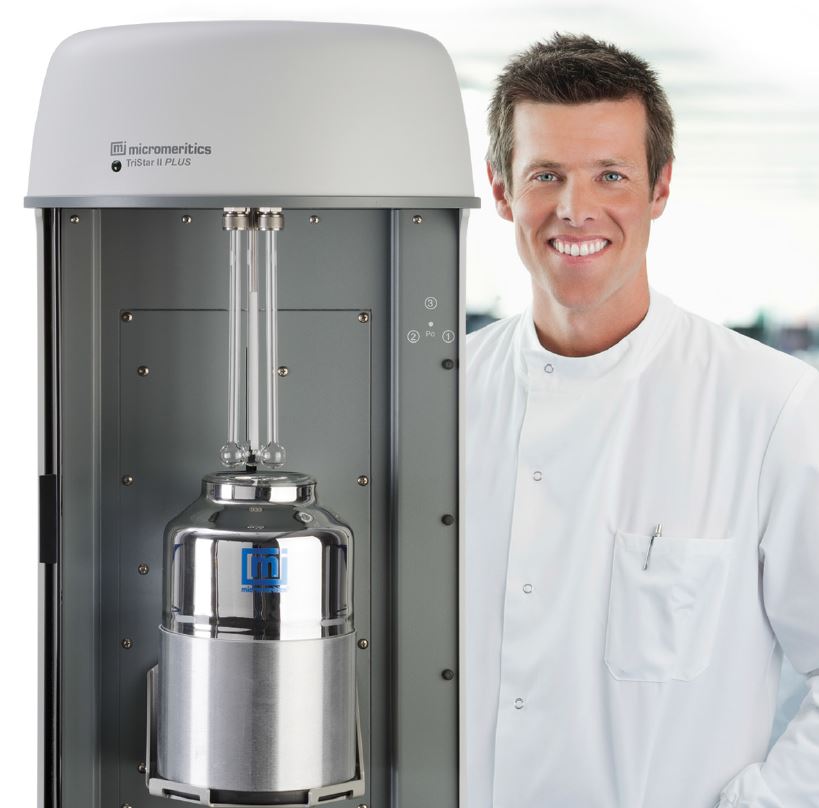Micromeritics Gemini VII surface area analyser
Micromeritics Gemini VII is a low cost, high speed, simple and reliable analyser used to determine single- and multpoint BET and Langmuir surface areas, total pore volume and micropore analysis.



Micromeritics Gemini VII surface area analyser
Micromeritics Gemini VII is a low cost, high speed, simple and reliable analyser used to determine single- and multpoint BET and Langmuir surface areas, total pore volume and micropore analysis.
| Manufacturer | Micromeritics |
|---|---|
| Product Series | Micromeritics Gemini |
| Measurement principle | Physisorption |
| Application | Surface Area & Porosity |
| Surface Area | From 0.1 m², total. From 0.01 m²/g, specific |
| Pore Volume | 4 x 10-6 cm³/g |
| Pressure Measurement Range | 0 to 950 mm Hg |
| Temperature | 10 to 35 °C (50 to 96 °F) operating. 0 to 50 °C (32 to 122 °F) non-operating |
Product Overview
Micromeritics Gemini VII series of surface area analysers rapidly and reliably produce accurate and repeatable surface area and porosity results.
Gemini’s unique capabilities emanate from the innovative use of sample and balance tubes. These tubes are identical in every aspect, including their thermal environment. The sample and reference reservoirs, like their associated tubes, are physically identical and are initially charged to the same pressure. During an analysis, differential pressure between reservoirs is monitored. This common mode technique assures that any differential pressure is solely due to adsorption by the sample and not to factors that lead to variations in free space during an analysis.
Choice of three model options:
Gemini VII 2390a
Ideal for rapid and accurate surface area determinations by single-point and multipoint BET and Langmuir methods, provides standard methods for total pore volume, micropore analysis by the t-method, and more.
Gemini VII 2390p
Provides additional precision with the addition of a saturation pressure (P0) tube that allows the system to monitor the saturation pressure of the adsorptive on a continuous basis during an analysis. This design feature permits a rapid measurement of the adsorption isotherm to near-saturation, as well as determination of pore size distribution.
Gemini VII 2390t
Has all the ability of the 2390p, including a P0 tube, with the addition of a larger Dewar and longer sample tubes for extended analyses. This provides the additional capability to measure the total adsorption-desorption process. With this data set, users can perform a BJH or Dollimore-Heal pore size distribution using up to 1000 data points.
- Benefits
- Applications
- Accessories
Benefits
Low Cost
System verification tests
Fully automatic operation
High throughput – up to four Geminis can be operated with single computer
Capable of measuring low surface area materials
Keypad- or computer-operated with Windows-driven software
Choice of analysis mode (scan or equilibrate)
No pressure overshoot
Common mode rejection of free-space error effects
No thermal-diffusion errors
Optional stainless-steel Dewars
21 CFR Part 11 software option
IQ/OQ Validation service (optional)
Applications
Pharmaceuticals
Surface area and porosity play major roles in the purification, processing, blending, tableting, and packaging of pharmaceutical products as well as the drug’s useful shelf life, its dissolution rate, and bio-availability.
Ceramics
Surface area and porosity affect the curing and bonding of greenware and influence strength, texture, appearance, and density of finished goods. The surface area of glazes and glass frits affects shrinkage, crazing, and crawling.
Adsorbents
Knowledge of surface area, total pore volume, and pore size distribution is important for quality control of industrial adsorbents and in the development of separation processes. Surface area and porosity characteristics affect the selectivity of an adsorbent.
Activated Carbons
Surface area and porosity must be optimized within narrow ranges to accomplish gasoline vapor recovery in automobiles, solvent recovery in painting operations, or pollution controls in wastewater management.
Carbon Black
The wear lifetimes, traction, and performance of tires are related to the surface area of carbon blacks used in their production.
Catalyst
The active surface area and pore structure of catalysts influence production rates. Limiting the pore size allows only molecules of desired sizes to enter and exit, creating a selective catalyst that will produce primarily the desired product.
Paints and Coatings
The surface area of a pigment or filler influences the gloss, texture, color, color saturation, brightness, solids content, and film adhesion properties. The porosity of a print media coating is important in offset printing where it affects blistering, ink receptivity, and ink holdout.
Projectile Propellant
The burn rate of propellants is a function of surface area. Too high a rate can be dangerous; too low a rate can cause malfunctions and inaccuracy.
Medical Implants
Controlling the porosity of artificial bone allows a better imitation of real bone that is more acceptable to the body for tissue growth.
Cosmetics
Surface area is often used by cosmetic manufacturers as a predictor of particle size when agglomeration tendencies of the fine powders make analysis with a particle-sizing instrument difficult.
Aerospace
Surface area and porosity of heat shields and insulating materials affect weight and function.
Electronics
By selecting high surface area material with carefully designed pore networks, manufacturers of super-capacitors can minimize the use of costly raw materials while providing more exposed surface area for storage of charge.
Fuel Cells
Fuel cell electrodes require high surface area with controlled porosity to produce adequate power density.
Geoscience
Porosity is important in groundwater hydrology and petroleum exploration because it relates to the quantity of fluid that a structure can contain as well as how much effort will be required to extract it.
Accessories
A variety of sample preparation devices are available to prepare batches of samples for surface area and pore volume analysis. They combine flowing gas and/or vacuum with heat to remove atmospheric contaminants, such as water vapor and adsorbed gas, from the surface and pores of the sample.

FlowPrep 060 applies both heat and a stream of inert gas to the sample for removal of adsorbed contaminants from the surface and pores. With six degassing stations, this sample preparation unit lets you choose the temperature, gas, and flow rate.
VacPrep 061 offers two methods for removing adsorbed contaminants. In addition to flowing gas, this sample preparation unit provides vacuum to prepare samples by heating and evacuation.
SmartPrep 065 applies a stream of flowing gas over the sample at elevated temperatures to remove adsorbed contaminants. Temperature, ramp rates, and soak times of each sample are individually controlled on the six degas- sing stations by a computer.
Smart VacPrep 067 is an advanced six-port system that utilizes vacuum to prepare samples by heating and evacuation. Each of the ports may be operated independently. Samples may be added or removed from degas ports without disturbing the treatment of other samples undergoing preparation. Degassing automatically terminates when the samples have completed all programmed steps.
Product Enquiry
SPEAK TO OUR AUSTRALIAN AND NEW ZEALAND TEAM
If you would like to enquire about this product, fill out this form and one of our product specialists will contact you shortly.
If you need help in the operation or repair of an instrument then please contact the Customer Help Centre directly.
Please note, product enquiries are only applicable to Australia, New Zealand, Papua New Guinea and Fiji
Or call us instead at (02) 9541 3500




 02 9541 3500
02 9541 3500

